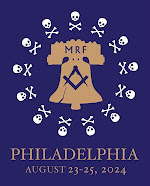Freemasonry is enjoying a burst of positive media in the British papers this weekend!
Prompted by the pending (August 18) release of a book titled The Craft: How the Freemasons Made the Modern World by John Dickie, there have been four (that I’ve seen) stories in the press that present Freemasonry calmly and fairly. I have not read this book yet, but here are some excerpts from the media coverage.
Actually, this started last Sunday, the second, with a review in The Times. Dominic Sandbrook writes:
“Despite being a Cowan, as Masons call non-members, I enjoyed this book enormously. Dickie’s gaze is both wide and penetrating; he is just as good on black American Freemasons, whose ranks include basketball star Shaquille O’Neal, as he is on the intricacies of French or Italian Masonry. He makes a persuasive case for Masonry’s historic importance, from its Enlightenment origins to its influence on the Mafia, Mormonism, and the Ku Klux Klan, all of which copied its rituals. He treats the conspiracy theories about Masonic influence in the British police with withering scorn, lamenting that ‘such stories regularly make it past the bullshit detectors of reputable newspapers.’ And, most refreshingly, he makes Masonry sound like an entirely sane, reasonable way to spend your time.”
From Friday’s Daily Express:
“So the Freemasons must be a secret society, right? Ask any Mason, and he will deny it. ‘We are not a secret society, but a society with secrets’ is the standard response, which is hardly reassuring. Anyone with even a mildly suspicious frame of mind is bound to assume the Brothers have something to hide. Yet the secrecy issue is not at all as straightforward as it might seem.”
And:
“When it comes down to it, when all the mysterious allegories, myths, and oaths are stripped away, what Masons are actually hiding is a series of very elementary moral principles: be a good person, [and] embrace tolerance and respect for your fellow human beings.”
In an interview published last Thursday in BBC History Magazine, Dickie is quoted at length.
“In Britain, I think there are two competing stories that dominate discussions of Freemasonry. On the one hand, they appear in the public imagination as a shady organization with something to hide. And this is what fuels the newspaper coverage they get—outlandish stories in which they are responsible for cover-ups of the sinking of the Titanic, or the Hillsborough disaster. People put two Freemasons in a row and make a conspiracy. Counter to that runs the Freemasons’ own narrative of their history, one of a noble, honorable tradition of brotherhood and altruism. This, admittedly, is much more dull. But somewhere in between these two stories is a vast, untapped world of extraordinary tales about what Freemasonry has meant to people, about the things it has got involved in and the paranoia that Freemasons have generated throughout their history, and also how Freemasonry has been hugely historically important.”
And:
“[Secrecy has] been a great selling tool for them—this idea that if you join the Masons, you will learn the secrets and become part of an elect band with access to privileged knowledge. But the way that Masons use the word ‘secrecy’ actually translates to something more like sacredness, because it’s used to create a sense of awe and specialness around their rituals, which are very important to them.”
In The Spectator yesterday, Dominic Green writes of “Demystifying Freemasonry.” Excerpted:
“The history of rubbish can be scholarship, but the history of scholarship is often rubbish. Hindsight diminishes earlier habits of thought and behavior, especially when, as with Freemasonry, they involve rolled-up trouser legs, coded handshakes, and a curious blend of mysticism and matiness. Yet Freemasonry was once a radical, even revolutionary, rite—to its adherents a harbinger of egalitarian, middle-class democracy, to its detractors a conspiracy of Jews, satanists and sex addicts.
“The Craft is a shadow history of modernity. Though more sober than most lodge meetings, it is, like its subject, ingenious and frequently bizarre. Freemasonry, John Dickie argues, is one of Britain’s ‘most successful exports,’ along with other club activities such as tennis, soccer, and golf. It is ‘a fellowship of men, and men alone, who are bound by oaths to a method of self-betterment.’ If this ideal of tolerant fraternity sounds modern—the absence of women aside—it is because it is.”
From what I’ve read, this book is not a gushing laughingstock of rosy public relations, like some silly Dan Brown story. Based on what I’ve seen, John Dickie speaks frankly, not untruthfully or unfairly, about our fraternity. I say that’s how one dispels ridiculous misconceptions in the minds of people who aren’t addicted to the flimsy fantasies promulgated by political and religious tyrants. I don’t think this media coverage will convert anyone who loathes Freemasonry, and I doubt it will bring appreciable numbers of curious men to the Inner Door, but the truth has great value, especially these days when facts, logic, and reason are hunted for extinction.










































































